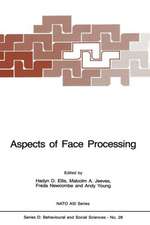The Nature of the Creative Process in Art: A Psychological Study
Autor Jaroslav Havelkaen Limba Engleză Paperback – 1968
Preț: 385.47 lei
Nou
Puncte Express: 578
Preț estimativ în valută:
73.76€ • 77.17$ • 61.27£
73.76€ • 77.17$ • 61.27£
Carte tipărită la comandă
Livrare economică 02-16 aprilie
Preluare comenzi: 021 569.72.76
Specificații
ISBN-13: 9789401186940
ISBN-10: 9401186944
Pagini: 248
Ilustrații: 230 p.
Dimensiuni: 155 x 235 x 13 mm
Greutate: 0.35 kg
Ediția:1968
Editura: SPRINGER NETHERLANDS
Colecția Springer
Locul publicării:Dordrecht, Netherlands
ISBN-10: 9401186944
Pagini: 248
Ilustrații: 230 p.
Dimensiuni: 155 x 235 x 13 mm
Greutate: 0.35 kg
Ediția:1968
Editura: SPRINGER NETHERLANDS
Colecția Springer
Locul publicării:Dordrecht, Netherlands
Public țintă
ResearchCuprins
I. Reality, Appearance, and the Creative Disposition.- Conventional Reality and Mental Organization.- Categorical, Collective, and Created Reality.- Evocative Function and Created Reality.- Contemplated Reality and Creative Appearance.- II. On the Conscious and the Unconscious.- Some basic properties of Consciousness.- The first two levels of organization: Pure experiences and Verballabels.- Freud’s basic approaches to the Conscious and Unconscious.- The origins of Emotionally charged Ideas and Repressive Functions.- III. On the Preconscious.- The “Pre-experiential” stage of Mental Organization.- An aspect of Preconscious: a Tacit Cognition.- The Problem of Double Significance: Articulated and Non-articulated elements.- The Origin of Poesis: Emotion and Preconscious.- IV. Some common Origins of Symbolic Functions and the Organization of Dreams.- Sleep, Dream and its Interpretation.- Censorship, Latent and Manifest Dream Work.- Symbol and Dream: Regressive and Progressive Processes.- The Dream as a Symbolic Narrative.- The Relation between Dream-work and Symbol-work.- Integration and Conclusion.- V. On Imagination and Symbolic Functions.- A Variety of Imaginative Functions.- Imaginative Inference.- Some Neuro-psychological Problems of Imagination.- Some Relations between Symbol and Imagination.- Ambiguity related to Imagination.- The Subjective and Radical Ambiguity of Imagination.- The Communicative Symbol, the Creative Symbol and the Contemplated Image.- Levels of Reaction to the Contemplated Image in Receiving Minds.- VI. On Style.- Inner disposition of style.- Overt stylistic expression.- Approaches to the history of art.- VII. Oedipus, Culture and Creativity.- General Orientation.- The Oedipus complex: Mental economy and Myth.- Creativity versus Neurosis.- ThePleasure and Reality Principles in Interaction: Neurosis and Culture.- Culture and Neurosis: The Father complex.- Archetypes and the Oedipus Myth.- The Dionysian and the Apollonian principles.- VIII. The Theory of Modes I: The Structure of Creative Intention and its Relation to Various Aspects of Mental Economy.- Introduction: On the Nature of Illusion.- Some Basic aspects of Intentionality.- Freud’s approaches to Creative Intentionality.- A further approach to the same problem.- The Reduction of Expenditure of Neural Energies.- Novelty and the Comic.- Creative Set and Curiosity.- Economy of Mental Expenditure as it relates to the Creative Process.- The Problem of Condensation.- Condensation and Emotion.- Conclusion about Intentionality and Condensation.- Regression and Mental Economy.- Childhood, Adolescent and Mature Imagination as it relates to Regression.- IX. The Theory of Modes II: The Tragic as Mental Function.- Three types of The Tragic.- Functions of Fantasy related to the Tragic.- The Relationship of Sublimation to the Tragic.- The Problem of the Uncanny.









